First he was exotic: home theater was bad enough, but to take the floor the trunk under the speaker in a hefty box thank you. But everything flows, everything changes, and the inclusion of a subwoofer in a car happened to audioshare time as a normal occurrence. The dilemma of whether to bet or not to bet, gave way to a more multi-faceted issue which put the better? And really what?
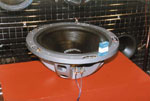
The subwoofer is not only the source low frequencies, but also makes the sound of the speaker system louder reduces the amount of distortion due to the fact that with other speakers removed the additional load. It is believed that the appropriate transfer of bass in a serious audiocompress WOOFER just necessary. Given the importance of subasavage link system manufacturers acoustics offer a wide range of products, so choose a what: from individual heads to active subs and everything else in between them. What and how to put already a matter of the installer. You can do the Boxing itself, use "prefabricated" ready box or a subwoofer.
Subwoofer performance depends on many factors acoustics of the cabin, characteristics of the head of the speaker, the type of acoustic design, shape and material from which it is made. In addition, sub, being part of the automotive audio system, cannot live separate from her life. In this connection the work subasavage link should be considered comprehensively. We are going to do.
Options configurations
A lot of them, but the main options for the inclusion of a subwoofer in a system of six. The first two use the passive crossovers between the amplifier output and speaker, the other with active crossovers that are in the signal path are placed between the signal source and the amplifier input. Naturally, each has its advantages and disadvantages, as outlined in a compressed the form in table N1.
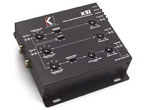
The option of using one amplifier is definitely the most economical, in fact on one machine at a time "cling" pair of speakers and a subwoofer, and the separation of the signal into frequency bands is inexpensive passive crossover. On the other hand, most of the standard crossovers include an RF filter with steep attenuation characteristics of 6 dB/octave pass and low-pass filter with a steep attenuation characteristics 12 dB/octave. The disadvantages of this configuration is that working from the same amplifier dynamics are not adequately protected at peak capacity. Except in passive crossovers, usually have a fixed frequency cutoff limits when configuring the system. In addition to all power one amplifier may simply not be enough.
Standard for passive crossovers the steepness of the characteristics of the low-pass filter (12 dB/octave) to play the bass is not quite adequate. As you know, our auditory organs are not able to localize the sound frequency below 100 Hz. That is, if your car autocomplete present WOOFER reproducing frequencies below this level, the listener on the idea don't need to know where is emitted bass. At the same time when there is insufficient the slope becomes audible frequency mid-bass, and sometimes even mid frequency range, and as a result can be defined, where there is a subwoofer. Thereby undermined the work the creation of spatial images.
The situation may be improved by using the filters of higher order 3rd (18 dB/octave) or 4th (24 dB/octave). Also you can own model and create crossovers required for a specific speaker settings. In the principle with a little stretch filters of 2nd order fit to work with bandpass subwoofers because they are less influenced by high frequency overtones and they have the most narrow bandwidth. In General standard filters of 2nd order are not recommended for the composition subasavage link.

Perfect, but fairly expensive option can be called the configuration of active crossover bass amp and the subwoofer. Why, in General, of course: components, in the presence of sufficient funds, you can pick up with a adequate to each other and the needs of the customer characteristics. Thus, large open opportunities for setting up the system, which ultimately leads to positive results in the sounding of the entire Autocomplex. The amplifier in this scheme, in principle, can be equipped with built-in crossover, although this is not always required.
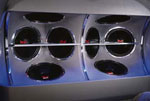
If the parameters are built-in filters meet the requirements, you can save and do without an active crossover. In this case first just one should pay attention to the order low-pass filter, which, as already it was said, should be no lower than third. It is also important the presence of smooth adjustment of the cutoff frequency, or the possibility of placing with replaceable resistor modules functions that allow you to integrate a subwoofer without audible "seams" at the junction of the bass and mid-bass range. However, in many budget models of amplifiers all the way round. Standard package contents suggests the presence of filters with insufficient slope features (6 and 12 dB / octave, respectively, for the HF and LF filters), as well as two fixed cutoff frequency, which, as already mentioned above, for bass is not quite acceptable. Our only choice is to disable the built-in crossover and offer the customer to fork out for a more suitable device.
Finally, another circuit consisting of active and active crossover a subwoofer (that is what is sold with the amplifier). Method, perhaps the easiest. The manufacturer takes care of agreement on the parameters of the amplifier and bass-head, calculates the desired for her working volume and complements the bass unit crossover. However, opponents of the use of active subwoofers in serious audiocompress a lot. Main arguments: small power amplifiers and nicolesy crossover. In most cases, these claims we agree, although the above-mentioned advantages (ease of installation) active subs will not take. Perhaps the only way to improve them the work is the use of more "respectable" active crossover.
What must be a crossover
Here is something to think about and preferably to do so at the initial stage build system. The variant of the device that has exclusively subwoofer outputs or the use of a crossover with bass and RF filters (in that case, if one amplifier subwoofer shakes speaker together with other drivers). If we consider a variant of the inclusion of the amplifiers according to the scheme biamping, here is a useful three-way crossover with subwoofer, low-mid frequency and high frequency the outputs.
The optimal parameters of the crossover are shown in table. 2
Table 2
Option
Comment
The steepness of the response attenuation
18 dB/octave (minimum) 12 dB/octave (minimum for stripe buildings)
Frequency slice
From 75 to 150 Hz. It is desirable to have a smooth frequency tuning slice
The presence of RF filter
Preferably, if in addition to the subwoofer amplifier swings higher dynamics the frequency range. In this case, the steepness of the characteristics The RF filter must be at least 12 dB/octave
Infrasound filter (subsonic)
Required for bass reflex subwoofers, for other desirable
Strengthening bass (usually at a frequency of 45 Hz)
Useful function
Switch polarity
Useful function
Adjustment the output signal
Usually not when there are adjustments of the input signal at amplifier
As we have said, the steepness of the attenuation characteristics of the signal is the most important parameter when selecting the crossover. Not high enough filter order (below the 3rd, that is below 18 dB / octave) will result in that together with the desired bass subwoofer will reproduce unwanted mid-bass or even MIDs. Thereby obtaining the effect the orientation of the bass that he is just not required.
How many Sabu need power
Here tend to come from the total capacity of the system and the cutoff frequency the subwoofer. The power distribution in percentage terms in a typical the car audio system depending on the frequency range looks under the table. 3 as follows.
Table 3
Frequency
Maximum power above the specified frequency
300 Hz
50%
600 Hz
25%
1200 Hz
10%
2400 Hz
10%
It is noteworthy that less than half the power it has at frequencies above 300 Hz. Therefore, at least 50% goes to the range below this the boundaries. Hence the rule that is applicable to many configurations: power bass amp should be one and a half times more power the front speakers. So, if the front is used 4-channel 4 x 25 watts, supplied to the subwoofer power the formula is: 1.5 x (25 W + 25 W). Get that bass should take about 75 watts.
You may need more. For example, when the cutoff frequency of the low pass filter above 150 Hz, in the case of low sensitivity speaker or subwoofer if the subwoofer is placed in the Luggage compartment and the access of bass in the cabin difficult. So when the client just wants a lot of bass". It is clear that in the selection the amplifier (or amplifiers) first of all take into account the number Woofers in the system, the value of impedance (LF-heads usually do 4 Ohm, with ordinary or dual voice coils) and a diameter of the diffuser.
The most effective and often used by installers a method of increasing power bass amplifier connecting the channels in the "bridge" (of course, if such option available). The inclusion of 2-kanalniy bridged usually gives more watt than the total capacity of its channels, when working in stereo. To example, the unit 2 x 50 W are supposed to give out 150 watts in "the bridge", and 4-channel (4 x 50 W) in stereoconfiguration will develop up to 150 watts channel.
Another option parallel connection of the speakers (Fig. 1). In this case plus the terminals are interconnected (sub-zero, naturally, too) in order to ensure safesee the movement of the heads. Improve the impact of the subwoofer is due to double reduction common impedance connected in parallel the voice coils. Because standard resistance car audio 4 Ohm total impedance two heads included in parallel will have a total of 2 Ohms, which gives the possibility bass amp to reach their potential.

Fig. 1
It is important to remember that rarely any amplifier can withstand "the bridge" the load impedance below 4 Ohms. In principle, exclude the use of two 4-Ohm speakers connected in parallel in this mode, because it included a "bridge" the amp "feels" only half of the load, which provide him dynamics.
Types subwoofers
What should be acoustic design WOOFER head, depends on many factors. Each type of subwoofer box, whether fully enclosed (sealed), bass reflex (ported.) or band-pass (band-pass), has its the advantages and disadvantages. Besides, much depends on the specific platform to build audiocomics, that is, the machine itself often dictates its conditions. And finally: is there definitely the best type bass body? Reply negative. Agree: if there was, then why need all the rest? On the contrary, closed boxes installed in the trunk vehicles with approximately the same frequency as that of the inverters.
Before we turn to the subwoofer enclosures, talk about why they are needed in principle. The problem is that the rear speaker generates same sound as his front, but in the opposite direction. Pure hypothetically, if you sit on the seat in the car, where the two the components are of equal intensity to affect hearing the authorities, there will be their neutralization, and you don't hear. On practice dynamics, deprived of proper acoustic design will be to radiate the high and mid frequencies, but not required us bass. This is because the sound wave emanating from the rear of the head, have to do a longer path to the ear of the listener. As a result high and mid frequencies are amplified, and low contrast weaken.

In short, without the "packaging" is not enough. From what do the boxes?
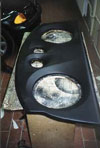
Preference for experienced installers very different, but most agree on one thing: without wood in one form or another good bass is not achieved. The two most common today material the coarse particle Board (MDF) and multilayer the plywood. These materials provide optimum acoustic characteristics, it is durable, simple in handling and is available at price. Even more affordable is the DSP, yielding characteristics (sound insulation, density, strength) to the previous two materials. Various types of plastic or plexiglass increasingly used for fault place or for demonstration purposes, but it is a certain concession on side of music.

Caseless subwoofers (free-air)
What are they good for is simplicity of execution.
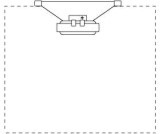
The installer does not need to "sculpt" Boxing and the owner to clutter up the trunk. Speakers are mounted in reinforced and pre-processed back shelf, and a cargo compartment acts as a kind of body, which prevents penetration into the interior of the sound emitted from the back the side of the head. The problem is that it is not always possible to make the trunk completely "deaf", and the above-described phenomenon of neutralization of low frequencies accompanied in the absence of what is called "deep bass", and in the decrease in the efficiency of the speaker.
Fully closed enclosure (sealed boxes)
The type of subwoofer enclosure, which effectively prevents the propagation of sound waves emanating from the rear of the loudspeaker. "Stale" air inside the box in this case acts like a spring controlling the fluctuations of the diffuser. Fully enclosed boxes easier to design than, say, a vented and bandpass subwoofers. They are not too picky on the part of the working volume calculations required for optimal operation of a driver, and more forgiving of incorrect data, specified by the manufacturer in the documents accompanying the product.
Air the cushion protects the speaker from low-frequency impulse noise, sometimes occurs when you turn on the system, supplying it with infrasound energy Yes and just driving on rough roads. This variant is more preferable, if you need to occupy a minimum of space in the trunk or cabin, as they are believed to play "deep bass" volume fully enclosed body may be small, although in this if it is necessary to know the measure. If the volume decreases below acceptable limits there is a significant loss of low-frequency component. With the increase volume impact in the field of infrasound frequencies increase, but then offset by the effect of saving space. In any case, the impact of such the subwoofer will yield larger counterparts bass reflex or bandpass types. At the same time compared them with frequency feature sealed enclosures in the field of recession smoother.
Bass reflex subwoofers (ported.)
Vented enclosures are in contrast to the fully closed use sound, coming from the rear speaker, in good powerful bass because the sound pressure is the sum of the radiation cone and port.
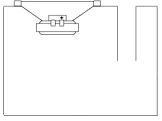
Accordingly, the use of this acoustic design improves the efficiency WOOFER head. At the same time phase inverters are more difficult to manufacture and more picky on part of the calculations of the working volume, the port configuration on the optimal frequency, impedance matching radiation diffuser and the phase inverter tube etc So the manufacturer options better to double-check.

But well the work performed, as a rule, is rewarded for it. It is believed that bass reflex subwoofer is capable of reproducing bass on an octave below the tank outlet.
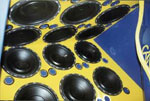
However, there is one "but": in this case, the box itself should be about five times. So the use of the enclosure with bass reflex design often it happens due to the willingness of the customer to part with a certain amount cargo compartment.
Bandpass subwoofers (bandpass)
This type of acoustic design can be called a hybrid of the previous two, because of its design has the features of both of them.
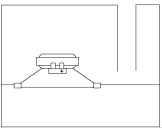
Typical bandpass sub consists of two chambers, one of which is access the outside has not, and second it is designed in the form of a tunnel port. Through him the bass in a concentrated form and is served in the salon. In concentrated because the speaker is mounted in the wall separating the two air-filled volume, and fluctuations of the diffuser meet resistance with both front and rear. As a result, the energy which is supplied to the loudspeaker, not sprayed, and spent more rationally, than in the closed and vented boxes. This cunning the structure of bandpass causes, on the one hand, its higher sound pressure level (up to 6 dB in comparison with closed housings), and another tendency to work in a narrow band of low frequencies. So thanks to polesovice that give the right choice, because by changing the volume of the chambers, you can either increase the magnitude of the sound pressure created bass head, or extend the boundaries of the frequency range. However, in order to successfully to manipulate the volumes, as well as to configure a tunnel port in according to the acoustic conditions of the cabin, need to have a great installators experience. Here the "boot camp" will obviously not be enough.
Selection dynamics
It is no secret that the size and type of acoustic design is largely determined by the power, sensitivity and frequency response Bass-head. Working at low frequencies, the subwoofer should lead in the movement of large masses of air, the size of which is proportional to the square the diffuser. Accordingly, drivers of larger diameter beget more sound pressure. The second factor contributing to the reproduction thunder bass, length the working stroke of the diffuser, i.e. the maximum allowable (from the point of view security dynamics) the boundaries of the amplitude of its oscillations.
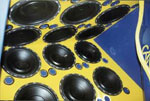
When choosing dynamics it is important to know what power the load it is capable safely withstand, how effectively the voice coil dissipates heat energy. This the parameter directly related to the diameter of the voice coil and the caliber wound on her wire. Iron rule: the power of the subwoofer to exceed the power supplied by the amplifier. Unfortunately, not all manufacturers of bass loudspeakers honestly tell us about this the feature, often for the purpose of advertising pointing somewhat overstated data (however, this sin, and manufacturers of amplifiers). Therefore, in order the speaker is not burned, it is better to check on it myself.

In turn, the sensitivity of the speaker determines how effectively it manages the power given to the load amplifier. In other words, the sound pressure created by the driver at a distance of 1 meter when applying for a signal power of 1 watt. However, sometimes the sensitivity index dynamics specified in the passport, it is not adequate to the actual situation. The thing is that the power (PH) creates a voltage (U), which depends on the nominal resistance (Rh) driver. If it is 4 Ohms (which is typical automotive acoustics), voltage is 2 V. But the 8 Ohm home speakers needed 2,83 V. this difference can be played that many manufacturers do, indicating the absolute sensitivity of a bass-head, that is measured when input voltage of 2.83 V.
Acceptable sensitivity for the subwoofer indicator is 90 dB, but as they say, the more, the better, because the dynamics more efficiently placing less demand on power amplifiers. This clearly illustrated in table. 4
Table 4
Sensitivity
Required power amplifier
DB
200W
DB
VT
DB
VT
90dB
100W
DB
VT
92db
VT
DB
50W
As you can see the difference even in 3 dB is substantial and allows twice to save on your power amplifier. But do not rush to RUB his hands. Here there are also some pitfalls. Subwoofers with high sensitivity often plagues a higher cut-off frequencies, and thus saving on power amplifiers, it is easy to lose the most that neither is deep bass frequencies. In other words, the sensitivity of the speaker is not should be considered separately from its amplitude-frequency characteristic (dependence of sound pressure on frequency).
Amplitude-frequency response of the subwoofer depends on the head, and on the type, the size of her acoustic design and acoustic features of the vehicle. It is considered that the greater the volume corps, the closer will be the lower limit of the frequency range to the maximum valid for this dynamics value. How to calculate without practical tests, that is, prior to the construction of the box? There is three "magic" features, referred to as the parameters of Thiel small (Thiele Small).
Options The Thiel - Small
When building a subwoofer, you cannot do without three basic options: the natural resonance frequency of the head dynamics (fs), its full q at the resonant frequency (Qts) and the volume of air with elasticity, equivalent to the elasticity of the suspension of the diffuser (Vas). They are usually listed manufacturer in the documents accompanying the product. Using these the parameters, it is possible by simple calculations to compare the approximate features multiple speakers (in particular, to the lower border the frequency range of head) at the early stages of the installation, when you have still not decided what type of box will be used and what Bass head right amount for optimal performance. The formula is as follows: ffb= fs Vas. Suppose you are choosing between two 10-inch heads Ultimate AU1050 and Jensen JSW104. Here are their parameters (tab. 5).
Table 5
fs
Qts
Vas
Ultimate AU1050
29 Hz
0,43
3,5 ft*
Jensen JSW104
31,3 Hz
0,40
2,4 ft
Having made the appropriate mathematical operation, receive such picture:
ffb
Ultimate AU1050
54,3
Jensen JSW104
48,5
Note. * American manufacturers usually indicate the volume in cubic feet, Europeans prefer liters. Convert feet to liters is by multiplying the first by 28.3.
As can be seen from the calculation results, despite the worst performance self-resonant frequency, the lower limit of the frequency range Jensen JSW104 is approximately 10% lower than the Ultimate AU1050 (of course, if these speakers to install in the same housings volume).
If you have decided on the type of acoustic design and know what dynamics of the volume needed for optimal operation, the equation to determine the lower boundary of the bass range of a particular model subwoofer head modified:
f3 = 0,8 ffb/ Vb (closed case)
f3 = 1,0 ffb/ Vb (for vented enclosures)
(f3 denotes a lower limit of the range reproduced by the subwoofer volume Vb).
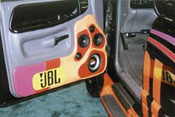
So in a sealed enclosure with a 0.75 cubic feet feature Ultimate AU1050 drops to a 50.1 Hz, and Jensen JSW104 to 44.8 Hz. In principle, these equations graphically demonstrate that with the increase of the housing lower bound the frequency range will tend to the maximum allowable for Bass-head. This is due to the fact that when she (the head) is placed in the box a certain volume, the resonance frequency of the subwoofer (f3) increases compared to the self-resonant frequency (fs) driver. Why clear: to the elasticity of the suspension of the diffuser adds a kind air spring inside the box. The greater the volume, the elasticity less, and the lower the cutoff frequency of the subwoofer.
For speakers free-air has its own formula: fob = fs/Qs and f3 = 0,9 fob. All the same Ultimate and Jensen showed the following results:
fob
f3
Ultimate AU1050
67,4
60,7
Jensen JSW104
78,3
70,5
Notice in this application Ultimate noticeably wins. In addition, in the eye immediately catches the trend towards increasing lower bounds frequency range dynamics at work in the open volume. Such is the price the ease of manufacture priamych subs. There, something to think about.

This raises the question: how low should play a subwoofer? It is known that modern cassette devices have lower the border of the reproduced frequency range from 50 to 30 Hz. The same refers to the FM stations. CD receivers, this indicator usually at around 20 Hz. However, even though people in principle perceives frequencies below 20 Hz, so deeply fall at all not necessarily. Rarely what the soundtrack, including CD-ROM, has a lower limit of 30 Hertz. This is rather an exception. But the rule is that the bass musical instruments played in the band from 40 to 60 Hz. The rest from 60 to 100 Hz. So the scope of the subwoofer usually starts (if the AFR to go from the bottom) with 40 Hertz.
Finally last comment. Though the parameters of Thiel small allow us to calculate many of the characteristics of the subwoofer, you should not forget that these calculations are for ideal conditions (typically the "ideal" is considered anechoic chamber, free from reverberation). Where will play a sub? Here namely, in the car, which is full as reflecting and absorbing surfaces. Therefore, the obtained characteristics inevitably superimposed the influence of the acoustic environment of the salon that for each transport funds are highly individual and very noticeable change in response the low-frequency region of the spectrum. In fact it is for this reason serious Autocomplex rarely completed ready boxes, so as in their manufacture are taken into account in the best case, the average cars.
Software for Saba
As we have seen, the calculation of parameters of acoustic design for Bass head not from simple. This conclusion is indirectly confirmed the existence of specialized software (software) that allows greatly facilitate the work of the installer. Such programs currently there are several (Blaubox, WinSpeakerz, Term-Pro, JBL and SpekerShop etc.), but they are largely similar. You can pick up a case for existing dynamics or, conversely, to pick up a bass head already constructed box.
Such programs allow you to compare the performance of one or another the loudspeaker in the buildings of various types. Most likely in the database you are looking for a speaker with a listing of all required characteristics. If not, then the database can be supplemented by the parameters of your the driver, whom you have supplied the manufacturer, and then to count all the necessary characteristics of Boxing for optimum frequency response and power the subwoofer. However, these parameters, as we mentioned earlier, all the same different from those that would be obtained by raising the box in the car. Here already own experience, knowledge of the individual characteristics of the vehicle, which allow to predict the behaviour of the bass system in salon car. The experience that comes with age. But all started with. It's worth a try.
Author: A. Smirnov; Publication: www.12voltsmagazine.com, www.cxem.net






